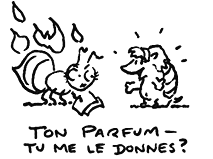|
|

overview
A single pronoun object is placed before the verb with which it is associated, except in the affirmative imperative when the pronoun object follows the verb.
The following table outlines the order and placement of pronouns when there is more than one object pronoun in a sentence.

| SUBJECT |
me

te

nous

vous

se
|
le

la

les
|
lui

leur
|
y |
en |
VERB |
 |
| Joe-Bob prépare sa leçon: Mon dieu, comme c'est difficile, l'ordre des pronoms objets! Le prof me dit qu'il faut les apprendre par coeur. Voici ma chanson ... |
|
Joe-Bob is preparing for class: My god, the order of object pronouns sure is difficult! The teacher says I have to memorize them. Here is my song ... |
|
However, in the affirmative imperative, the pronoun objects follow the verb.

| VERB |
-le

-la

-les
|
-lui

-leur
|
-moi (m')

-toi (t')

-nous

-vous
|
y |
en |

y and en
Y always precedes en, and both precede the verb except in the affirmative imperative.
When used with other pronouns, y and en always follow any other pronoun object,
even in the affirmative imperative.

 |
| Bette: Tu vas au gymnase? |
|
Bette: Are you going to the gym? |
| Tammy: Oui, j'y vais. Et toi, Fiona? |
|
Tammy: Yes, I'm going there. And how about you, Fiona? |
| Fiona: Non, j'en viens. Vas-y avec Bette. |
|
Fiona: No, I've just been there. Go with Bette. |
| Tammy: Il y a des footballeurs là-bas? |
|
Tammy: Are there any football players there? |
| Fiona: Oui, il y en a. Je te retrouve dans une heure chez toi? |
|
Fiona: Yes, there are some. Should I meet you at your house in an hour? |
| Tammy: D'accord. Dis Fiona, je n'ai pas de rouge à lèvres. Tu m'en donnes? |
|
Tammy: OK. Say, Fiona, I don't have any lipstick. Can you give me some? |
| Bette: Et n'oublie pas le parfum. C'est essentiel aussi, hein? Allez, donne-nous-en. |
|
Bette: And don't forget the perfume. It's also essential, right? Go on, give us some. |
|


direct and indirect object pronouns together
Sometimes there will be both a direct and an indirect object pronoun in the same sentence.
The direct object pronoun is usually closest to the verb of which it is the object.
However, the order of direct / indirect object pronouns is reversed in the third person singular and third person plural (le lui, le leur, etc.).
In this case, the indirect object is closest to the verb.

 |
| son parfum? |
| Fiona me le donne? |
Fiona gives it to me? |
| Fiona te le donne? |
Fiona gives it to you (singular)? |
| Fiona le lui donne? |
Fiona gives it to him/her? |
|
 |
| Fiona nous le donne? |
Fiona gives it to us? |
| Fiona vous le donne? |
Fiona gives it to you (plural)? |
| Fiona le leur donne? |
Fiona gives it to them? |
|
|

Remember that in the affirmative imperative, me and te become moi and toi.

 |
| Tammy: Fiona! Fiona! Ton parfum, tu me le donnes!? Tu vas me le donner? Donne-le-moi! |
|
Tammy: Fiona! Fiona! Your perfume? Are you giving it to me? Are you going to give it to me!? Give it to me! |
| Fiona: Pardon, je ne comprends pas. Vous voulez du parfum pour aller au gymnase? |
|
Fiona: Sorry, I do not understand. You want perfume to go to the gym? |
|

negation
In simple tenses, like the present, future, imperfect, and passé simple, the object pronouns are placed between the ne and the verb.
In compound tenses, like the passé composé, the plus-que-parfait etc., the object pronouns are placed between the ne and the auxiliary verb.

 |
| Plus tard au gymnase. |
|
Later in the gym. |
| Tammy: Personne ne fait attention à nous! Tu vois, sans parfum, aucun mec! Pourquoi est-ce que Fiona ne nous en a pas donné? |
|
Tammy: No one is paying any attention to us. You see, no perfume, not a single guy! Why didn't Fiona give us any? |
| Bette: Et bien, c'est parce qu'elle ne comprend pas l'art de la séduction. |
|
Bette: Well, that's because she doesn't understand the art of seduction. |
|


|
|
|
|